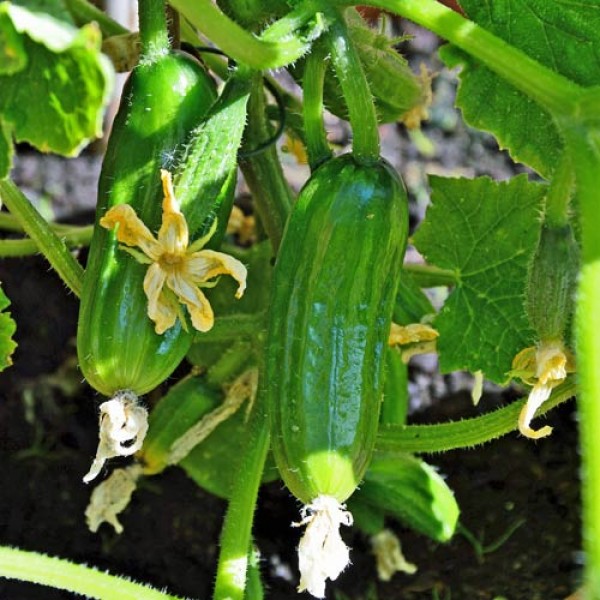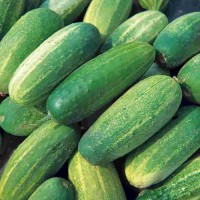
Growing Cucumbers & Gherkins
Cucumbers - heat-loving and productive
A distinction is made between cucumbers and gherkins.
Cucumbers require a lot of heat and are only worth growing outdoors in warm regions where spring starts in Febuary/March. In other regions, they should be grown in a greenhouse. However, they are an easy to grow, tasty and high-yielding garden vegetable.
Gherkins, on the other hand, can be grown anywhere outdoors.
Location
As already mentioned, cucumbers are very heat-loving. Outdoors, they need a sunny, wind-protected spot with a trellis. This can be a trellis, a garden fence, stretched wires/cords or a special climbing frame. The soil should be loose and rich in humus. It should be well-drained and spongy but retain sufficient water to permit rapid, uninterrupted growth and to help maintain the high humidity.
In the greenhouse they also like higher humidity than tomatoes and should not be grown together with them.
Cucumbers are high nutrient-demanding plants and may only be grown in the same location every four years.
Sowing
Cucumbers should always be raised indoors. Only the robust gherkins can be sown directly outdoors, but only after the danger of frost has passed (i.e. around end of April). For pre-cultivation, place three seeds in an 8 cm pot. The seeds need warmth (22-24°C) to germinate and must always be kept well moist. When the young plants have two to three leaves beyond the cotyledons, you can transplant them into the bed. For transplanting into the garden, wait until mid-May. The individual plants need a minimum spacing of 100 x 40 cm. You can also provide the small plants with a small protective "greenhouse" by placing large glass jars over them.
Care
Cucumbers need large quantities of water which must be applied regularly during fruiting and dry periods to prevent crop damage. Nettle manure or an organic fertiliser can be used every 2-3 weeks.
Cucumbers are often trained vertically, either tied in to a series of horizontal wires or, alternatively, twisted around vertical strings tied to the plant stems and then to overhead wires. Then the main stem is cut when it reaches the top wire to allow the cucumbers to develop on lateral branches.
For outdoor cucumbers, a trellis, fence or similar is often sufficient and here also the main stem can be cut at about 1 metre to stimulate the growth of side branches.
Protection from pests and diseases
Good neighbours are lettuce, radishes, cabbage or beetroot.
In addition to downy mildew, there is often infestation with powdery mildew in greenhouses. In this case, the affected leaves must be removed. As a preventive measure, ensure sufficient planting distance and good ventilation. As powdery mildew also tends to occur in dry weather, there is often nothing to do but discard the entire plant.
Root rot fungi and wilt diseases, such as fusarium, cause leaves to go yellow and wilt despite sufficient watering. Here, too, only complete removal of the entire plant helps. Since wilt disease is caused by the Fusarium fungus in the soil, the soil should also be generously replaced.
Aphids sometimes transmit cucumber mosaic disease, which can also affect courgettes, melons and pumpkins. Symptoms of cucumber mosaic virus include mottled leaves and fruits and stunted plants. To control it, keep aphids away.
Harvesting
You can harvest fresh cucumbers from two months after sowing.
Ripe cucumbers are the most succulent and tasty and regular cutting allows more to develop. It is ideal if you cut ripe cucumbers (with a knife) every few days. Many cucumbers have very rough leaves and skins, so it may be beneficial to wear gloves. Do not tear off the cucumbers, then you can easily injure the tender shoots. From September onwards, you should remove all flowers so that the cucumbers still on the plant can ripen before the frost.
Pick cucumbers when they are 20 to 30 cm long. Gherkins are crunchiest at a length of 9 cm, you should not let them get any bigger. Cornichons have a maximum length of 5 cm. If you have forgotten to pick in time and the cucumbers have grown too large, you can still make stewed cucumbers. However, they may have lost their typical flavour by then.
Cucumbers can be kept in the refrigerator for one to two weeks.
Manufacturer
Name: | Chili-Food-Wissen |
Address: |











